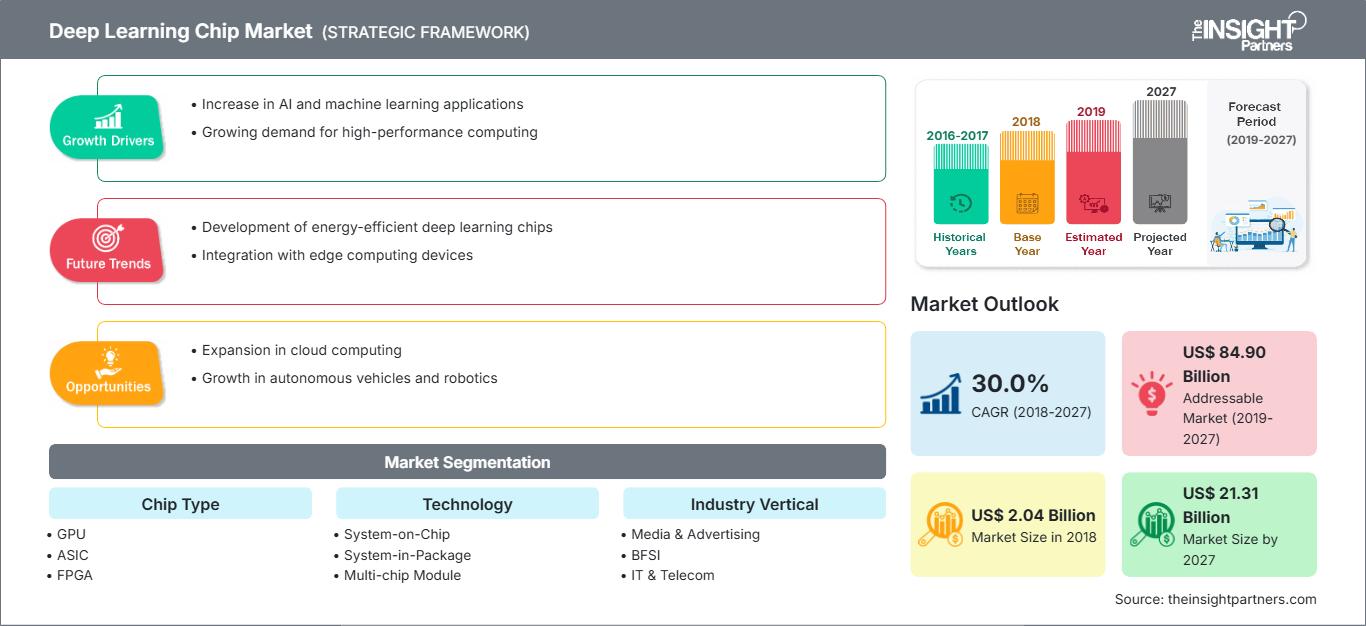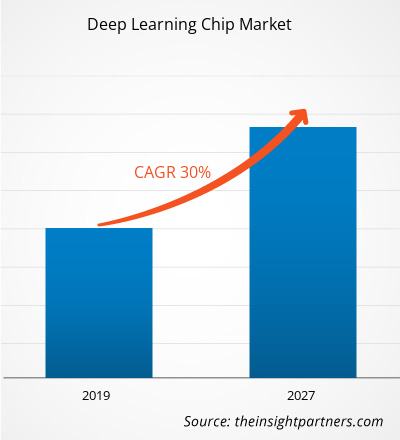El mercado mundial de chips de aprendizaje profundo alcanzó los 2.040 millones de dólares en 2018 y se espera que crezca a una tasa de crecimiento anual compuesta (TCAC) del 30,0% durante el período de previsión 2019-2027, hasta alcanzar los 21.310 millones de dólares en 2027.
América del Norte lidera el mercado global de chips para aprendizaje profundo y se prevé que sea el principal contribuyente a los ingresos durante todo el período de pronóstico. El desarrollo de chips para aprendizaje profundo se sustenta en la inversión a gran escala de gigantes tecnológicos para generar patrones a partir de la enorme cantidad de datos producidos. El auge de la computación cuántica y la implementación de chips de aprendizaje profundo en robótica impulsan el crecimiento de este mercado en los países norteamericanos.
Perspectivas del mercado
La importancia de la computación cuántica contribuye al crecimiento del mercado de chips para aprendizaje profundo.
La computación cuántica permite realizar cálculos en segundos, mientras que otros procesos tardarían mucho más. Las computadoras cuánticas representan una transformación innovadora de la inteligencia artificial, el aprendizaje automático y el análisis de macrodatos. Por lo tanto, se espera que el auge de la computación cuántica impulse el crecimiento del mercado de chips para aprendizaje profundo. Además, la computación cuántica ofrece beneficios en diversos ámbitos, como la optimización de carteras, la detección de fraudes y la gestión de riesgos, así como en áreas que requieren retroalimentación de datos inmediata. De esta manera, un solo procesador puede realizar cálculos complejos en cuestión de segundos. Asimismo, gracias a la escala y el tamaño de internet, el aprendizaje profundo permite gestionar grandes conjuntos de datos a un costo muy bajo. Por consiguiente, se prevé que estos factores impulsen el crecimiento del mercado global de chips para aprendizaje profundo.
Obtendrá personalización gratuita de cualquier informe, incluyendo partes de este informe, análisis a nivel de país y paquetes de datos de Excel. Además, podrá aprovechar excelentes ofertas y descuentos para empresas emergentes y universidades.
Mercado de chips de aprendizaje profundo: Perspectivas estratégicas

-
Obtenga las principales tendencias clave del mercado que se describen en este informe.Esta muestra GRATUITA incluirá análisis de datos, que abarcarán desde tendencias de mercado hasta estimaciones y pronósticos.
Información en tiempo real sobre el comportamiento del consumidor y una mayor eficiencia operativa impulsarán el crecimiento general del mercado de chips de aprendizaje profundo.
El entorno empresarial se está volviendo muy competitivo y, para competir eficazmente, las empresas dependen hoy en día de información útil y análisis de negocio. Tradicionalmente, las herramientas de análisis de negocio se utilizaban para proyectar las ventas a partir de datos de eventos ocurridos una semana o un mes atrás. Con la llegada de la inteligencia artificial, que aprende en tiempo real y ofrece recomendaciones basadas en patrones, las empresas tienen una gran oportunidad para aplicar el aprendizaje profundo en diversos procesos y así comprender mejor el entorno empresarial y a sus clientes.
Teniendo en cuenta estos factores, la inteligencia artificial permite a las empresas mejorar la eficiencia operativa, reducir los costes operativos, mejorar la calidad del servicio y la experiencia del cliente.
Información sobre tipos de chips
Las unidades de procesamiento gráfico (GPU) dominaron el mercado de chips para aprendizaje profundo en 2018, mientras que se prevé que los circuitos integrados de aplicación específica (ASIC) sean el segmento de mayor crecimiento durante el período de pronóstico. Esto se debe a que los ASIC son muy específicos y menos flexibles, pero constituyen una de las opciones de hardware de mayor rendimiento disponibles para aplicaciones de inteligencia artificial.
Perspectivas tecnológicas
Los conjuntos de chips para aprendizaje profundo incluyen sistemas en chip (SoC), sistemas en paquete (SIP), módulos multichip y otros tipos de conjuntos de chips. El segmento de sistemas en chip (SoC) ostentó la mayor cuota de mercado de chips para aprendizaje profundo en 2018, ya que contribuye a reducir el consumo energético, el espacio ocupado por los grandes sistemas y los costes.
Perspectivas verticales de la industria
El mercado global de chips de aprendizaje profundo se clasifica en los sectores de banca, servicios financieros y seguros (BFSI), comercio minorista, TI y telecomunicaciones, automoción y transporte, sanidad, medios de comunicación y entretenimiento, y otros. El sector BFSI ostenta la mayor cuota de mercado, mientras que se prevé que el sector sanidad sea el de mayor crecimiento. Factores como la reducción de costes operativos, la adaptación a las normativas y regulaciones cambiantes, la concentración en la actividad principal y la integración de la automatización en los procesos de negocio son otros factores clave que impulsan el crecimiento del segmento BFSI en el mercado de chips de aprendizaje profundo.
Los actores del mercado de chips para aprendizaje profundo se centran principalmente en la mejora de sus productos mediante la implementación de tecnologías avanzadas. La firma de alianzas, contratos, empresas conjuntas, financiación y la apertura de nuevas oficinas en todo el mundo permiten a la compañía mantener su marca a nivel global. A continuación, se enumeran algunos de los avances recientes:
2019: NVIDIA se ha asociado con Hackster.io para lanzar el AI at the Edge Challenge, una competición en la que los desarrolladores utilizan el kit de desarrollo NVIDIA Jetson Nano para crear proyectos creativos y únicos y tienen la oportunidad de ganar premios por valor de 100.000 dólares.
2019: Intel anunció sus planes para expandir su fábrica de Oregón y producir chips de 7 nm. Esta nueva fábrica constituirá la tercera fase de D1X, un enorme complejo industrial que Intel inició en 2010. Cada una de las dos primeras fases abarcó 1,1 millones de pies cuadrados, creando unas instalaciones combinadas equivalentes a 15 almacenes Costco. La tercera fase incrementará el espacio de fabricación de D1X en aproximadamente un 50 %. Además, Intel afirma que la expansión de su fábrica le permitirá responder un 60 % más rápido a la escasez de chips.
2019: Huawei lanzó HiSecEngine USG12000, el primer AIFW de nivel T de la industria. El HiSecEngine USG12000 está equipado con chips de IA Ascend, que proporcionan capacidades de detección inteligente, así como defensa perimetral inteligente para redes empresariales.
Perspectivas regionales del mercado de chips de aprendizaje profundo
Los analistas de The Insight Partners han explicado en detalle las tendencias y los factores regionales que influyen en el mercado de chips para aprendizaje profundo durante el período de previsión. Esta sección también analiza los segmentos y la geografía del mercado de chips para aprendizaje profundo en Norteamérica, Europa, Asia Pacífico, Oriente Medio y África, y Sudamérica y Centroamérica.
Alcance del informe de mercado de chips de aprendizaje profundo
| Atributo del informe | Detalles |
|---|---|
| Tamaño del mercado en 2018 | US$ 2.040 millones |
| Tamaño del mercado para 2027 | US$ 21.310 millones |
| Tasa de crecimiento anual compuesto global (2018 - 2027) | 30,0% |
| Datos históricos | 2016-2017 |
| período de previsión | 2019-2027 |
| Segmentos cubiertos |
Por tipo de chip
|
| Regiones y países cubiertos |
América del norte
|
| Líderes del mercado y perfiles de empresas clave |
|
Densidad de actores del mercado de chips de aprendizaje profundo: comprensión de su impacto en la dinámica empresarial
El mercado de chips para aprendizaje profundo está creciendo rápidamente, impulsado por la creciente demanda de los usuarios finales debido a factores como la evolución de las preferencias de los consumidores, los avances tecnológicos y una mayor conciencia de los beneficios del producto. A medida que aumenta la demanda, las empresas amplían su oferta, innovan para satisfacer las necesidades de los consumidores y aprovechan las tendencias emergentes, lo que impulsa aún más el crecimiento del mercado.

- Obtenga una visión general de los principales actores del mercado de chips de aprendizaje profundo.
SEGMENTACIÓN DEL MERCADO GLOBAL DE CHIPS DE APRENDIZAJE PROFUNDO
Por tipo de chip
- GPU
- ASIC
- FPGA
- UPC
- Otros
Por la tecnología
- Sistema en chip
- Sistema en paquete
- Módulo multichip
- Otros
Por sector vertical
- Medios y publicidad
- BFSI, TI y Telecomunicaciones
- Minorista
- Cuidado de la salud
- Automoción y transporte
- Otros
Por geografía
-
América del norte
- A NOSOTROS
- Canadá
- México
-
Europa
- Francia
- Alemania
- Reino Unido
- Rusia
- Italia
- El resto de Europa
-
Asia Pacífico (APAC)
- Australia
- Porcelana
- India
- Japón
- Corea del Sur
- Resto de Asia Pacífico
-
Oriente Medio y África (MEA)
- Arabia Saudita
- Sudáfrica
- Emiratos Árabes Unidos
- Resto de Oriente Medio y África
-
Sudamérica (SAM)
- Brasil
- Argentina
- El resto de SAM
Perfiles de empresas
- Dispositivos Micro Avanzados, Inc.
- Alphabet Inc. (Google)
- Amazon.com, Inc.
- Baidu, Inc.
- Huawei Technologies Co., Ltd
- Corporación Intel
- Corporación NVIDIA
- Qualcomm Incorporated
- Samsung Electronics Co., Ltd.
- Xilinx, Inc.
- Análisis histórico (2 años), año base, pronóstico (7 años) con CAGR
- Análisis PEST y FODA
- Tamaño del mercado, valor/volumen: global, regional y nacional
- Industria y panorama competitivo
- Conjunto de datos de Excel
Informes recientes
Testimonios
Razón para comprar
- Toma de decisiones informada
- Comprensión de la dinámica del mercado
- Análisis competitivo
- Información sobre clientes
- Pronósticos del mercado
- Mitigación de riesgos
- Planificación estratégica
- Justificación de la inversión
- Identificación de mercados emergentes
- Mejora de las estrategias de marketing
- Impulso de la eficiencia operativa
- Alineación con las tendencias regulatorias






















 Obtenga una muestra gratuita para - Mercado de chips de aprendizaje profundo
Obtenga una muestra gratuita para - Mercado de chips de aprendizaje profundo